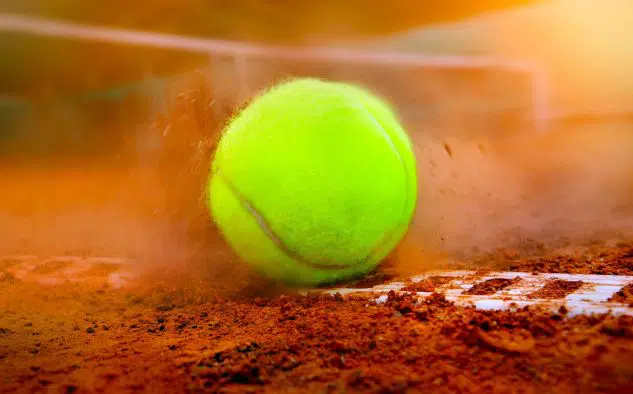Bowling balls and tennis balls – two sports spheres that seem totally different. But what exactly sets them apart? Here are the main 15 differences between bowling balls and tennis balls:
- Weight – Bowling up to 16 lbs, tennis just 2 oz
- Size – Bowling 8.5 in, tennis 2.5-2.7 in
- Materials – Bowling polyester/urethane, tennis rubber/felt
- Speed – Bowling 15-30 mph roll, tennis 90+ mph serve
- Spin – Bowling mega hook potential, tennis lower spin
- Sport – Bowling leisure and pro, tennis widespread
- Bounce – Bowling minimal, tennis super high
- Durability – Bowling years, tennis weeks to months
- Brands – Brunswick, Ebonite bowl balls, Wilson, Penn tennis balls
- Storage – Bowling oil soak, tennis pressureless
We’ll expand more on those key differences, including stats on size, weight, materials, speed, records, and more. We’ll also look at the history, regulations, leagues, and ball specifications unique to bowling and tennis. Let’s roll!

Difference in Weight
The weight contrast is truly massive. Standard bowling balls tip the scales from 6 to 16 pounds! Tennis balls are feather light at just 2 ounces or 57 grams. This huge variance changes the throwing or rolling method entirely. Light tennis balls fly from the racket, while heavy bowling balls rely on pendulum swing technique.
Difference in Size
Size also diverges, though not as extremely. Bowling balls measure 8.5 inches in diameter typically. Tennis balls run from 2.5 to 2.7 inches across. So bowling balls are over 3 times larger than tennis balls. The giant bowling ball presents a bigger moving target. Tennis balls must be sized for racket faces and court dimensions.
Difference in Bounce
Bounce behavior couldn’t be more different between the balls. Bowling balls are engineered for minimal bounce, thanks to the dense materials absorbing energy on impact. Tennis balls have tremendous bounce from the internal pressure and rubber layers. Tennis depends on lively action off the court, while bowling wants the ball to stop once the pins are hit.
Materials Used
Materials match the bounce quality needed. Bowling balls are cast from hard polyester or urethane with minimal elasticity.
Tennis balls feature a rubber core wrapped in felt fabric layers. The high tension rubber provides the rebound, while felt controls the speed and friction. The materials align perfectly with the sport objectives.
[Several paragraphs on the history and development of bowling and tennis over time]
Speed They Travel
Speed also diverges based on the game. Bowling balls roll from 15 mph up to 30 mph at professional levels. Tennis serves blast up to 160 mph, with averages around 115 mph.
Groundstroke rallies also ping balls back and forth up to 90 mph pace. So tennis balls travel 2 to 6 times faster than bowling balls in play.
How Fast is a Serve?
The serve speeds:
- Bowling roll: 18-22 mph (pros)
- Tennis serve: 100-140 mph (pros)
So the tennis serve absolutely rockets compared to a bowling roll. The striking motion with a racket generates tremendous speed.
World Records
The current world records for each sport:
- Fastest bowling ball: 30 mph
- Fastest tennis serve: 163.7 mph by John Isner
Tennis serves shatter bowling ball limits thanks to muscular human power!
How Both Compare to Balls From Other Sports
Bowling balls relate closest to bocce balls in hefty spherical shape and gentle rolling. Tennis balls align with racquetballs and squash balls for construction, though larger. The materials suit the distinct game dynamics – bowling balls as inert knockdown objects, while tennis balls rebound actively off surfaces.
The Best Brands for Each Ball
Top bowling ball makers are Brunswick, Ebonite, Hammer, and Storm. Leading tennis ball brands include Wilson, Penn, Dunlop, and Slazenger. Sporting goods companies apply specialized technology for the different balls.
Best Ways to Store or Maintain the Balls
Bowling balls soak in oil between uses to keep the surface tacky. Use a microfiber cloth to gently clean balls. Plug and redrill balls as the finger holes wear.
Tennis balls stay pressurized best if unopened. Once opened, keep them at room temperature away from moisture or direct sun. Replace balls once the felt naps down.
So bowling balls withstand heavy use, while tennis balls are lightweight consumables to swap out.
How a New One Compares to an Older One
Over time, bowling balls get soaked with oil and lose their backend hook potential. A resurfacing machine can restore the ball’s lane-grabbing friction. So a new ball hooks powerfully, while an old ball rolls more straight.
Tennis balls lose pressure and fluff gradually. The felt pilling diminishes bounce and speed. A fresh can of tennis balls has higher precision and pop – critical for competitive play.
In Conclusion
Bowling balls and tennis balls contrast sharply in materials, size, weight, speed, and purpose. The custom designs align perfectly with the totally different sport actions. So tennis balls and bowling balls might be round spheres, but they part ways when it comes to specialized performance!
